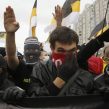
Russian Nationalists and Pro-Democracy Activists Blame the North Caucasus on National Unity Day
Publication: Eurasia Daily Monitor Volume: 8 Issue: 205
By:

On November 4, the so-called Russian Marches took place in cities across Russia. The biggest rally took place in Moscow, where an estimated 14,000 people participated. For the first time at the annual rally, Russian nationalists appeared alongside popular Russian democrats. The well-known Russian pro-democracy leader Aleksei Navalny and his supporters joined forces with the nationalists to demand an end to the government’s financing of the North Caucasus and to condemn the ruling United Russia party (https://www.apn.ru/news/article25258.htm).
The convergence of the Russian nationalists and pro-democracy leaders had been predicted before, but the process is far from complete. Reports suggested that people with very different views participated in the Russian nationalist rallies across Russia, including the Just Russia party, democratic activists, the Communist party and others. Slogans such as “Russia for Russians” and “Stop Feeding the Caucasus” appeared to dominate the rallies (https://www.ridus.ru/news/8768/).
This newly-emerging political consensus poses a challenge to the current status quo in Russian politics, which is carefully constructed by the ruling regime to stifle popular participation in political life. The North Caucasus issue increasingly appears to be the incipient catalyst of the Russian nationalist and political opposition movement. At least one of the Russian nationalist leaders, Aleksandr Potkin, reportedly called on participants in the November 4 rallies to gather again on December 4, the day of the State Duma elections (www.gazeta.ru, November 4).
So far, the government’s response has been unconvincing. On November 5, pro-government youth organizations staged their own Russian March in Moscow. An estimated 15,000 young people participated, but the pro-government rally clearly lacked purpose or the resolve to propose or defend anything novel (https://www.ridus.ru/news/8650/).
Because the Russian authorities have placed severe restrictions on voicing unofficial opinions and thwarted several attempts by opposition parties to register officially, genuine public protest in Russia manifests itself in poorly organized actions under extremist slogans. Extremist slogans, including those using expletives aimed at North Caucasians, still seem to dominate among the Russian nationalists. However, strictly political slogans are also making their way into the public protests, including slogans condemning United Russia. While some Russian liberals find it repulsive to cooperate with the Russian nationalists, others think that liberals should work with the dissatisfied Russian people as they are and try to civilize their response (https://ymalbats.livejournal.com/150170.html).
A Russian March was also held in Stavropol Krai, which is part of the North Caucasus Federal District, and the nearby Russian regions of Krasnodar and Rostov-on-Don. The ethnic Russian majority in Adygea planned to march, but cancelled their action after they were warned off from doing so by officials (www.kavkaz-uzel.ru, November 4).
The Russian nationalists rallied not only under anti-North Caucasian slogans, but also the Russian imperial white-yellow-black flag. The symbolism could hardly have been received well in the North Caucasus, given that under the Russian Empire, Caucasians were officially designated as second-class citizens. Increasingly more robust Russian nationalist rallies will inevitably contribute to an increase of nationalism in the North Caucasus.
On November 4, an estimated 300 people in Kabardino-Balkaria blocked the Rostov-on-Don–Baku (Azerbaijan) highway, a major Russian highway. The protesters demanded a “just sentence” for Aslan Cherkesov, a Kabardino-Balkaria native who was given a 20-year sentence for killing a Russian soccer fan in Moscow. The trial was widely perceived as highly biased and the prison sentence as unusually harsh for such an incident. The protesters stated that while killings of ethnic Russians are noticed by the Russian government, when North Caucasians are killed in Russian cities by Russian nationalists, those incidents are ignored by the Russian federal government and regional authorities. “The prime minister [Vladimir Putin] laid flowers on [Yegor] Sviridov’s grave,” one of the protesters in Kabardino-Balkaria told the Kavkazsky Uzel (Caucasian Knot) website. “But when my compatriots are killed [in Russian regions] we don’t receive even short condolence messages from the presidential administration.” The protesters in Kabardino-Balkaria stated they would continue blocking highways to attract the attention of the Russian authorities and demand justice for Aslan Cherkesov (www.kavkaz-uzel.ru, November 4).
Russian nationalists have worked out their own plan of action in the North Caucasus. It is noteworthy that all three possible scenarios envisage various types of isolation of the North Caucasus from the ethnic Russian regions and their possible secession. According to the first, most favorable scenario, Moscow should introduce military rule in the North Caucasus to stop the mass migration of the North Caucasians to ethnic Russian regions and to ensure funds reach the “right” people. Following a five-year period, the region should hold a referendum on secession from Russia and reconstruction within the country. The second scenario contemplates the immediate secession of the most problematic regions of the North Caucasus – Dagestan, Chechnya and Ingushetia. According to the nationalists, under current circumstances a third scenario is unfolding in the North Caucasus. They allege that the North Caucasians are increasingly expanding into ethnic Russian regions and that the North Caucasians’ demands on the Russian budget and resources are rising exponentially. The nationalists suggest this might lead not only to the eventual secession of the North Caucasus, but to the exodus of ethnic Russians from nearby Russian regions such as Stavropol (https://vnatio.org/arhiv-nomerov/node88/).
While the extreme program of the Russian nationalists is unlikely to be implemented, it is likely to have an impact on Kremlin policymaking. The Russian government will be forced to cut subsidies for the North Caucasus, even more so because of its own shrinking resources. The government has already reneged on its previous promises of lavish investment in the region (see for example EDM, November 2). Rising Russian nationalism, with its anti-North Caucasian thrust, is likely to prompt the Russian authorities to adopt harsher policies toward this region rather than create a viable opposition to Putin’s regime. This may provoke yet another cycle of violence in the North Caucasus and further galvanize Russian nationalists and the general Russian public.




